Do-it-yourself heating of a country house. Do-it-yourself heating of a country house - we carry out calculations and choose equipment
The main problem with heating country house The fact is that heating is carried out not by a solid structure, but with the help of individual elements that need to be properly selected and installed. We will tell you what you need to do if you want to do the work yourself.
1
The heart of the heating system is the boiler. It is he who produces heat and transfers it to the coolant. By design, the boilers are similar to each other: the equipment is equipped with several chambers, in the first of them the fuel burns (combustion chamber), and in the second there is a coolant (heat exchanger).
Boilers can be single-circuit and double-circuit. The second scheme has its visible advantages - a double-circuit boiler will not only help heat the house, but also become a source of warm water. But when purchasing a single-circuit boiler, you will additionally have to spend money on buying a boiler. The main difference in boilers is the type of fuel used.
Furnace for home heating
The first kind - electric boilers. Heating with their help has its own characteristics. The main disadvantage is the high cost of use, since the boiler consumes electricity in large quantities, and the cost of this "fuel" is quite high today. But such boilers work almost uninterruptedly. It is convenient to install them in houses that are not yet connected to the central gas main.
One of the most common -. It is quite easy to explain their huge popularity. Heating with their help is characterized by economy, ease of use, constant fuel supply. Of course, this option is only suitable for those whose house has direct access to the gas main - otherwise, laying pipes, gasifying the house and arranging a mini-boiler room will be very expensive.
Oil-fired boilers are rarely used. This is due to the high price of diesel fuel and gasoline. The second reason is the need to equip a powerful ventilation system for waste disposal. Without it, the smell of gasoline will fill the whole house. There are also boilers that run on solid fuel, which can be wood or peat. Such equipment is relevant for houses that are not connected to the gas system. The main advantage is that their fuel is cheaper than electricity or gasoline. True, there are plenty of cons. For example, in order to carry out uninterrupted heating, you need to purchase and deliver fuel to your home, you also need to manually load fuel into the combustion chamber. Typically, solid fuel boilers are used as a fallback option if heating is temporarily turned off.
2
The heating system of the house has a second mandatory component - pipes. Depending on the location of the pipes, the heating system is single-pipe and two-pipe.
In the first case, the connection scheme will be as follows: radiators and pipes are connected in series with each other, which can adversely affect the efficiency of the entire system - if the first radiators heat up to the required temperature, then the temperature of the rest can drop to +23 ° C. This will not be enough to warm up a large room. That is why many choose the two-pipe option.

Choosing a radiator for your home
The connection scheme for a two-pipe system also has several varieties. The first option provides parallel connection all radiators to the pipe. The second system is a beam connection, when the pipes of all radiators are connected to one riser. The second option requires more expenses due to the need to use a large number of pipes. In addition, pipes may vary in material of manufacture. In the past few years, home heating has been increasingly carried out using PVC pipes, which are lighter and cheaper than metal pipes. They hardly clog and can be installed behind drywall sheets to hide infrastructure.
The choice of radiators is also an important step. The most common materials are cast iron and aluminium. For a country house, it is better to choose cheaper and lighter ones, which are characterized by a high level of return. Their only drawback is that they are sensitive to temperature changes.
3
To properly heat your home, you need to make the right calculations. This will allow you to find out what power boiler you need to buy, how many radiators and how long pipes are needed. There is nothing complicated here. Start by calculating required power for the boiler. Of course, you can purchase equipment by eye, but in this case, there is a high probability of miscalculating and buying a boiler that is not suitable for your home. As a result, you will either overpay for the fuel consumed by the boiler or freeze in the house due to insufficient equipment power.

Radiator under windows
To determine the power, you need to use the formula W \u003d k * S / 10, where S is the area of \u200b\u200bthe house in square meters, W is the power of the equipment in kW and k is the correction factor, which depends on the building region.
To the result obtained, it is desirable to add another 25% of the power reserve for an unplanned event. For example, if the temperature in winter drops below normal. Round the result and you can proceed to the choice of the boiler.
The next step in the calculations is the definition of radiators for each heated room in the house. This process is quite laborious, so we decided to carry out an example of calculations for a room with an area of 10 square meters with one outer wall. In this case, the power should be about 1.2 kW.
If there are two or more windows in the room or there is a wide doorway, which leads to a decrease in the temperature in the room, the power must be increased to 1.3 kW. Now you can calculate the power that will provide the necessary heating in each room: multiply the area of \u200b\u200bthe room by the power indicator (1.2–1.3) and divide by 10. The result must be multiplied by 5 and rounded up to a whole number. The result is the number of sections necessary to warm up the room. heating radiators. For reliability, you can add a few more sections to the required number.
Next, you need to draw a diagram of the house on paper, where to mark the boiler, radiator, piping to ensure the supply of coolant to all rooms. So it will be easier for you not to make a mistake with the calculation of the number and length of pipes, the number of radiators.
4
In addition to such system elements as the boiler, pipes and radiator, you will need to purchase other parts and spare parts, including nipples, pipe gaskets, brackets for installing radiators. If you decide to do the installation yourself, do not forget about the need to tie all the elements, for which it is better to use strong linen threads.

Independent installation of the heating system
In order for the heating system to function without interruption, it is important to observe the following rules:
- Radiators should be mounted only near window openings. The distance from the radiator to the floor is at least 10 cm, to the window sill - at least 6 cm.
- The heating system must be equipped with a drain (at least one), which is necessary for preventive work on replacing the coolant.
Then the system is filled with coolant, after which a test run is carried out. If you have purchased a gas boiler, then specialists should establish its operation - from the initial start-up to maintenance. It is undesirable to carry out all the stages with your own hands - the services of specialists will minimize the risks of malfunctions.
Be sure to check for leaks and other problems. If you notice any malfunctions in the boiler, immediately turn off the system and start setting it up. Most often, problems arise in the areas where the sections are joined, where the strapping was performed poorly. So it is better to immediately carry out all the work as efficiently as possible.
And thermal pumps. Network gas is considered the cheapest fuel, but it is not always possible to connect the gas heating of a country house. Prices and options for alternative fuels, features of new systems - in this material.
Consider the main types of fuel that can be used to heat private households in our latitudes:
- firewood and coal;
- fuel oil, diesel, gasoline, mining;
- network and bottled gas;
- electricity (grid, solar or wind);
- geothermal energy.
Each of these types has its pros and cons. When choosing the type of heating, it is important to take into account the financial possibilities of the family for the purchase and operation of the system, the availability of fuel and the possibility of combining different types fuel.
Saving on qualified craftsmen can result in system malfunctions. That is why it is important to think through everything to the smallest detail, competently draw up a project and entrust the work to professionals.
What is a heating system project?
For the design, the area of heated premises, the power of the boiler and the probable heat loss are taken into account. The number in each room and the length are calculated. The number of windows, doors and the nature of the wall materials also matter.

Detailed calculations allow you to optimally spend money and further minimize the cost of maintaining the system. Water heating can be included in the heating system.
When designing a system, it is necessary to take into account the climatic features of the region. For example, in the conditions of the Far North, a liquid fuel boiler will be inefficient, since its fuel loses its ability to ignite even at minus thirty degrees.
What heating is better for a private house: comparing different types
So, before installing the boiler, you should find out:
- is it possible to connect to the network gas pipeline;
- what fuel is most available in the place of residence;
- is there enough power in the local power grid to connect heating appliances;
- how much heat energy is required to heat the house.

Solid fuel and its features
The use of solid fuel materials, coal and firewood is considered an obsolete type of heating. However, this assertion is debatable. In a situation where housing is inaccessible to road transport place, this type of fuel is a non-alternative option. The power line may not meet the required loads, there is no network gas pipeline, and bottled or liquid fuels are difficult to deliver. Here it remains, proven for centuries. Although it does not heat up automatically, it guarantees warmth in the most severe frosts.
Note! The cost of heating with solid fuel is one and a half times less than the cost of heating with a gas installation.

Stove heating with water circuit wooden house- one of the most common options. Firewood in a wooded area is a cheap commodity. The same can be said about coal in coal mining regions. Wood and coal top the list of the cheapest ways to heat a country house. So do not rush to discount this type of heating.
Consider the obvious advantages and disadvantages of a solid fuel boiler
| pros | Minuses |
| Profitability. The cost of a cubic meter of firewood starts from 1 thousand rubles, coal - from 5 thousand per ton. | The efficiency of solid fuel boilers does not exceed seventy percent. |
| Solid fuel boilers can run on two types of fuel, such as wood and gas. | Soot formation, soot and smoke formation. |
| The possibility of using different types of solid fuels: coal, pellets, manure, firewood. | The need for constant supervision and the addition of fuel. |
| Ease of installation and operation of water heating from a wood-burning stove | |
| Offline work |
It remains to clarify only one question: what is the price of solid fuel boilers for heating a private house? Customer reviews of such installations indicate that it is better to select devices in the middle price segment - from 30 to 70 thousand rubles. Their power is enough to heat a small country house with an area of 100-150 square meters.

Note! A simple wood stove needs to be refilled about once every five to seven hours. Modern high-tech pyrolysis plants are able to work continuously for twelve hours.
Oil boilers
Gasoline, kerosene, diesel, machine oil (working out) can be used as liquid fuel. The latter option is often used by garage owners. A small stove using such fuel is capable of heating a room with high quality. This option is not suitable for a residential building, since oily soot is formed during the operation of the boiler, which is almost impossible to clean.
Advantages and disadvantages of a liquid fuel system
| pros | Minuses |
| Operates in automation mode with minimal operator intervention | The cost of boilers and accessories for them (prices start at 40 thousand rubles for low-power appliances) |
| Fuel Availability | Fuel price |
| System autonomy | The need to install special fuel storage systems |
| High efficiency - up to ninety-five percent | Short equipment life due to sulfur oxide formation |
Note! Many may not like the specific smell generated during the operation of a liquid fuel boiler.

Electric heating of a country house: prices and options for appliances
Electric boilers are divided into induction and electrode. If the system assumes the presence of a water circuit, then electrode models are considered more effective. They have a high efficiency. However, induction appliances are safer.
On sale you can find other options for heating devices. First of all, these are modern infrared systems. Underfloor heating or panels with plates that emit infrared waves heat the room quickly and efficiently. Wave energy does not heat the air, but the objects in the room. Those, in turn, give off heat to the air currents.

- another type. Silent fans drive air through the heating elements. The power of modern batteries with convectors allows you to heat large areas.
Advantages and disadvantages of electric home heating
| pros | Minuses |
| Ease of installation | Electricity cost |
| Relatively low cost devices | Dependence of the heating system on interruptions in the power system |
| High efficiency | |
| Mobility (if necessary, the device can be rearranged) | |
| High room heating rate | |
| Availability of energy source |
Advice! Considering the electric heating of a country house, options and prices for appliances, pay attention to one of the most aesthetic and modern types of system - a heating baseboard. It will not interfere with arranging furniture and at the same time will heat the room as efficiently as conventional batteries.

Related article:
What is this latest heating system? Price, reviews of system owners, review the best manufacturers, recommendations of professionals for self-installation - in this material.
Network gas, cylinders and gas holders
Network gas is available to 67 percent of the population of our country. Where there are gas pipelines, other ides have not been used for a long time heating systems. Cheap blue fuel does not require the creation of storage facilities, storage for the future or constant monitoring of the heating device. The cost is relatively low and starts from 20 thousand rubles.

If for some reason network gas is not available, alternative options can be used. You can connect several cylinders to the boiler or install a gas tank - a system with a capacious storage of liquefied gas. The container is filled with special machines. These alternative options are completely autonomous and depend only on the ability to refuel tanks. Such gas will cost a little more than network gas.

Advantages and disadvantages of gas heating
| pros | Minuses |
| Economical due to low fuel cost | Risk of gas poisoning |
| No need for strict control over the system, gas boilers work in automatic mode | The impossibility of self-installation of the system |
| Long service life of devices | |
| Precise temperature control capability |
Note! Gas heating is the most environmentally friendly way to heat your home. With a gas boiler, there will be no foreign smell, burning or soot in the room.
Geothermal heating as an alternative
Is it possible to heat private houses without gas and electricity? New developments make it possible to use thermal energy to heat a home. The principle of operation of such a system is similar to the principle of operation of a refrigerator.

Article
When planning year-round living in a country house, you need to worry about creating an efficient heating system. There are currently a large number various types heating devices, which differ not only in their technical characteristics, but also in cost. Therefore, a compromise is needed between the need to obtain optimal temperature indoors and fuel costs. That is, you need to correctly think over and implement the heating of a country house: compare options and prices according to important criteria and make the right choice.
Typical circuit autonomous system life at home
When choosing heating systems one of the important criteria is the availability in a particular region of a certain type of fuel, which has an acceptable cost. This can be centralized gas supplied, the possibility of ordering solid fuel, or other options. It is important that a particular type of fuel does not run out in the next 5-10 years, otherwise the heating system will not be able to pay off, except for those living in the northern regions. Therefore, if it is known in advance that, for example, coal mining may end, then it is worthwhile to soberly assess the prospects for reworking the heating device or take one in advance that is designed for several types of fuel.
Another criterion is the efficiency of heating devices. In financial terms, this means that the same area when using a device with a greater heat output will take less time and fuel consumption will decrease, that is, there will be savings in the range of 20-40% of the total estimated costs. In practice, greater efficiency will affect the ability to generate more heat in the room for a certain period of time.
Attention! The amount of heat transfer depends not only on the efficiency, but also on the heat release of a particular type of fuel. Therefore, it is necessary to calculate total area at home and make thermal calculations.
The choice of heating system also depends on the temperature difference between the street and the room. That is, it must develop the required power. First of all, it depends on the material of the housing in which combustion takes place, the method of heat transfer, the coolant used, the radiators used, as well as the effectiveness of the thermal insulation of the house.

Heating a country house: options and prices of the most popular
According to the method of heating, the systems are divided into autonomous and centralized. The choice between them is not so unambiguous, since they differ in many ways, which in specific cases can play a significant role, depending on priorities.
Heating system
Autonomous are considered the most reliable, since their performance depends on the quality of maintenance and timely repair of all devices and components. The owner of the house independently monitors the performance and maintains it in proper condition or invites specialists who are able to carry out quality service and identify possible breakdowns at an early stage.

In terms of functionality, autonomous devices are superior to centralized ones, since they can be used not only for heating purposes, but, for example, to obtain hot water or for cooking, depending on the fuel used. However, the cost of such equipment will cost several times more than for a centralized one. In terms of dimensions, it will occupy a large space and in some cases, to ensure the safety of the house, it will be necessary to allocate a separate room. e.
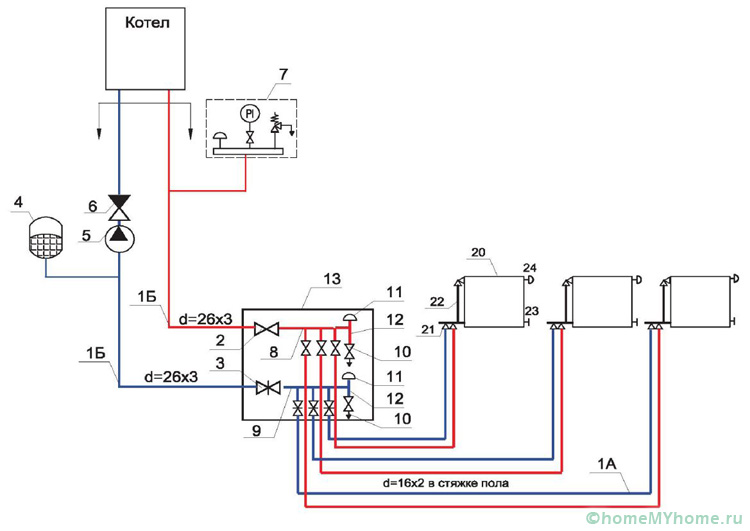
According to the method of heating, autonomous sources are divided into the following:
- Water.
- Electrical.
- Solid fuel.
Central heating
District heating is the most common in urban areas, but outside the city it is very rare, since most villages used to get by with heating from solid fuel stoves. It can be water or gas. Water heating involves the presence of a heating source outside the building, to which several more houses or areas are connected. That is, the coolant is supplied through communications directly to the consumer, who independently determines how to dispose of it. A centralized gas system means supplying fuel through pipes to a house that has all the necessary heating equipment.

The main advantage of centralized systems is the absence of problems with the search and supply of fuel to the end user. In most cases, the cost of heating turns out to be much cheaper than if you had to independently search for and order a suitable type of fuel. Equipment, in comparison with autonomous heaters, is cheaper, with the exception of gas supply, when a boiler is required.

However, there are also disadvantages:
- Complete dependence on the service provider. At any time, the supply of coolant or fuel may stop for various reasons. The technical conditions of deliveries may not always correspond to the declared ones, especially during the period of seasonal overloads. For the consumer, this is fraught with insufficient heating of the premises or equipment breakdown.
- The need for monthly payment for consumed services, which, as noted above, do not always meet the standards.
- There is no way to control the coolant temperature or fuel pressure, which can decrease or, on the contrary, be very high.
Water heating
Choosing the heating of a country house, options and prices, many stop on the water one. It is a closed system of water circulation through pipes through all the premises of the house from the heating source to the heat dissipators (radiators). Heat transfer is carried out by means of a heat carrier.
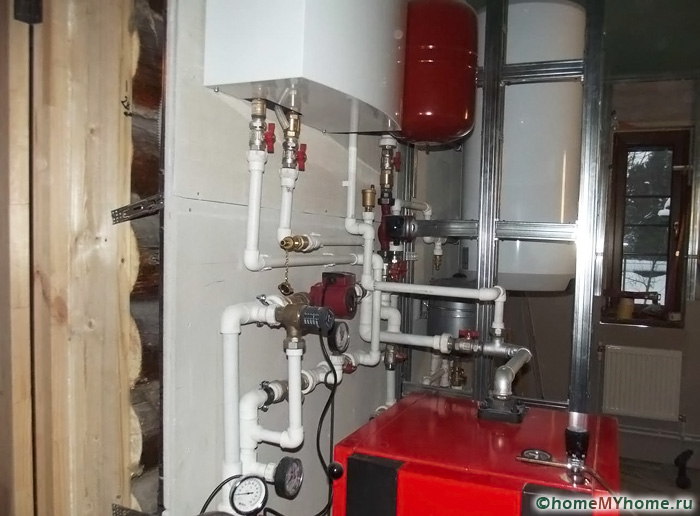
The main role in the water heating system is played by a boiler designed to heat the coolant. It can be gas, solid fuel, electric or diesel. The heating power is determined by the size of the combustion chamber and the type of fuel. The creation of water heating from a wood-burning stove is the cheapest for regions with a large number of forest plantations.
Related article:
A separate review provides information on the use of polypropylene pipes, their installation and prices.

According to the method of ensuring the circulation of water in the pipes, the systems are divided into the following:
- With natural circulation. The movement of the coolant is created when water is heated by creating a temperature gradient and changing its density. It does not require the installation of additional pumps for pumping. The circulation speed is sufficient for efficient heat transfer to the external environment. However, its efficiency reaches a limit when heating an area close to 100 m 2 and above, so the scope is limited to small houses. The advantage is the economy of the system and ease of implementation. The possibility of creating high-quality heating of a private house without gas and electricity.

- With forced circulation. Unlike the previous case, in this situation the circulation pump is connected. Its task is to ensure a sufficient circulation rate of the coolant to heat houses with large areas (more than 100 m 2) or buildings with more than two floors.

Related article:
Principle of operation. device and selection criteria for these units in a special publication of our portal.
Any water heating has the following disadvantages:
- Due to the passage of the coolant through the pipes, it loses its temperature and, as a result, a significant temperature gradient can occur. That is, the rooms closest to the boiler will be warmed up more than the remote ones.
- system inertia. After turning the heating on or off, depending on the size of the communications, it takes some time to reach the desired temperature.
- The need to lay pipes on the inner or outer surface of the walls. The first option can be implemented only until the cosmetic repairs of the rooms are completed, and the second one can worsen the design of the premises due to the type of external communications.
- The coolant must be constantly heated.
- Noise during operation of systems with forced circulation.
Useful information! Water heating allows you to provide the house with hot water for domestic and household needs. In addition, it becomes possible to install water-heated floors, in addition to standard heating radiators, and obtain the required temperature distribution in the room.
Electric heating of a country house: options and prices
Electric heating systems are among the most popular in country houses, as they are easy to install (with the exception of warm electric floors), provide almost instantaneous heating and are completely silent during operation. A huge variety of devices allows you to choose the most optimal not only in terms of technical characteristics, but also in terms of installation method. When choosing electric heating for a country house, options and prices can differ significantly and depend not only on technical characteristics, but also on decorative exterior design. Types of devices are of the following types:



- Cable or film systems of heat-insulated floors.

The main requirement for the stable operation of electric heating is the presence of an uninterrupted supply electric current. In addition, the wiring must be calculated for a certain power of the heating elements. Therefore, it is necessary to find out in advance the maximum permissible load to the network from household appliances and which wires are designed for. If the load power is at the limit, then it is recommended to run a separate wire from the electric meter to the installation of a circuit breaker, which will protect the main network from overloads and emergencies.
The advantage of electric heating is high efficiency, relative cheapness of electricity and equipment, undemanding maintenance, compact size of devices, and no noise during operation. The disadvantages include increased requirements for electrical wiring, as well as the need for stable parameters for current and voltage in the network.
Gas heating
Gas heating is one of the most economical, which allows you to recoup the cost of all purchased equipment in the shortest possible time, depending on the intensity of its use. The system includes a boiler, pipe communications, radiators, a circulation pump, a heat exchanger, an expansion tank, as well as control and safety devices. The boiler provides heating of the coolant by means of a heat exchanger, which circulates in a closed system. To prevent emergency situations in case of overheating of the coolant, an expansion tank is used. Heat is transferred to the premises through radiators.

Depending on the area of \u200b\u200bthe house, it is necessary to select the number of heating circuits. This will ensure uniform heating of the premises and minimize heat loss by reducing the length of communications. Gas heating for a country house with a large area shows itself to be the most efficient and in demand, and equipment options and prices are quite flexible.

The advantages of such systems are: efficiency, ease of use, low cost of fuel. The disadvantage is the danger of using gas equipment with improper control, the need for quality organization.
Important! Gas boilers are devices with increased explosion and fire hazard. Therefore, it is necessary to provide appropriate protective measures and observe the installation rules in accordance with the current rules and regulations.
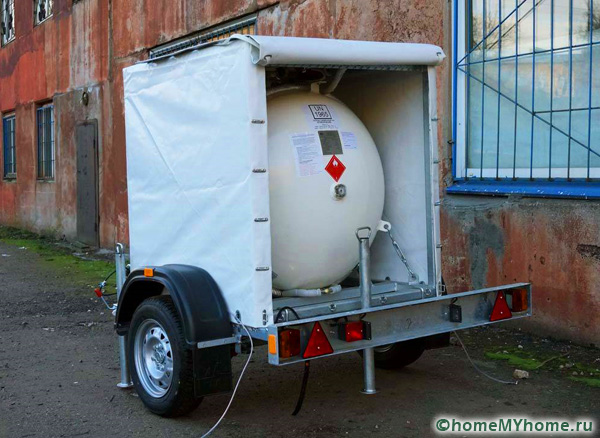
Related article:
Wood burning stove
When choosing heating for a country house, it is necessary to consider such options and prices that meet all the criteria and are fully justified from a financial point of view. This means that one should not forget about stove heating with wood, the use of which can be justified by the impossibility or high cost of laying centralized communications or the cheapness of fuel.

A feature of such structures is their massiveness. Due to thick walls or large volumes, they can provide long-term preservation of temperature or instantaneous heating. They can be made by hand from metal or. This makes such stoves quite a budget option, which is suitable for houses with a small area. If it is necessary to expand the heating area, a boiler is installed on top of the furnace and connected to the water heating system.

Useful information! Specifications it is quite difficult for an average person to calculate a home-made stove, as a result of which the heating system may turn out to be inefficient. Therefore, when choosing, it is recommended to pay attention to mass-produced models from well-known manufacturers. Acceptable price
Increasingly, a country house is being transformed from a vacation spot into a permanent home. This circumstance dictates the need to create comfortable conditions residence, in particular, maintaining an acceptable temperature regime in the premises. The task is greatly simplified if the house is located close to energy sources. However, most often you have to consider all types of heating a country house to make the right decision. At the same time, a combination of two or even three heating options is often provided in order to insure yourself against unforeseen circumstances.
Types of heating
Gas heating
The use of gas as an energy source for heating a country house is currently the most optimal solution. Modern gas boilers do not require constant monitoring, are easy to maintain, have compact dimensions and are safe to operate.
Gas boiler
Energy supply is carried out along the main line, from which there is a tie-in to the consumer. The supply of gas, as a rule, is uninterrupted. At the same time, housing is not always located in close proximity to the highway, therefore, to create an autonomous heating system at home, other ways of organizing heating should be considered.
Gas heating of a country house has a number of advantages:
- Installation and operation are quite simple. The standardization of fasteners and fittings for gas equipment greatly simplifies the complexities of installation.
- Some types of installation work are quite possible to do on your own. But at the same time, commissioning work should be carried out by specialized specialists.
- The equipment has a high efficiency compared to other heating methods. The use of a pressure pump in the system allows you to quickly deliver the coolant to distant rooms and heat them up.
- The relatively low cost of gas makes it possible to obtain cost savings.
- A high level of safety in the operation of gas boilers in compliance with fire and explosion safety standards. In addition, there is practically no possibility of poisoning by fuel combustion products.
- Additionally, safety is guaranteed by the presence of control and measuring equipment.
- A small amount of substances harmful to environment, makes the heating process environmentally friendly.
- The combination of significant power equipment with its compactness. The gas boiler is harmoniously integrated into the interior.
- Sufficiently long service life of boiler equipment.
For an objective assessment of the characteristics of gas heating of a country house, it should be understood that:
- All activities for its organization must be coordinated with the relevant organizations, which requires a certain amount of time.
- The use of gas equipment for heating is advisable if the area of heated premises is more than 100 sq.m.
Electric heating
Electric boiler
Traditional heaters powered by electricity have water or oil as a heat carrier. The principle of operation in this case is to heat the refractory element and transfer thermal energy to the coolant, which circulates through the heating system, giving off heat to the premises. At the same time, the required temperature regime is provided for a long time, which allows saving electrical energy.
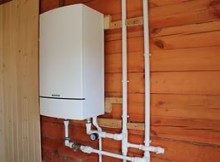 electric boiler
electric boiler The design must be carried out by a suitably qualified electrician. In the course of calculations, it is necessary to take into account the inevitable losses of thermal energy and the power of the unit, as well as the area of \u200b\u200bthe heated room and the set temperature in it.
The heating system consists of an electric boiler, pipes and radiators. The determining parameter for achieving the required temperature is the power indicator of the boiler equipment.
In addition, it is necessary to calculate the number of required radiators. This should take into account their material, floor area and design features radiators.
Warm floor
The implementation of the heating system is more economical and effective way home heating. Fundamentally, it does not differ from the case when boiler equipment is used. The difference lies in the fact that there are no radiators, and heat is transferred from the coolant through pipes installed in a concrete screed. The heat carrier is heated by a heating element.
A similar method of heating creates uniform heating throughout the volume of the room by moving warm air upwards in accordance with the laws of physics.
 Warm floor
Warm floor It is characterized by certain difficulties. At the same time, it is possible to regulate the power of the equipment and save energy.
Electrical panels
The organization of heating in a country house by installing electrical panels greatly simplifies installation work. The heating device consists of thin double plates. In them, the air is heated and removed through the grate or special openings. The convective heat transfer used in this case eliminates all possible problems with heating. The panel is mounted on the wall, and the power cable is connected to the house power supply system. Special skills are not required for this.
The number of convectors is determined in accordance with the volume of the heated space and the power of the equipment. It is recommended to mount the panels next to the balcony door or below the windows. This location is due to the fact that heat loss can occur in these places.
For a country house, this solution is optimal, provided that there is a constant power supply. It takes a short time to reach the required temperature.
Warm baseboard and infrared heating
It should be understood that to solve the problem of heating the entire area of \u200b\u200bthe house using an infrared heater is not enough. It is effective in cases where you want to warm up the room in the shortest possible time. The device of the heating element has undergone certain improvements, and modern devices use heating elements or film heaters. A reflector is used to give direction to the flow of thermal energy.
 Such panels are more like a backup heating option.
Such panels are more like a backup heating option. The design of film heaters allows you to mount the device on the wall. The introduction of decorative elements into its design makes it possible to add an additional detail to the interior.
It is possible to heat the premises of a country house with panels, but a warm baseboard system is more efficient. The name of the device fully corresponds to the installation method: it is placed around the perimeter of the room in the form of a floor plinth. Electricity consumption is reduced due to the low power of the system. This design is aesthetically pleasing. The warm plinth does not take up extra space, but passes in accordance with the configuration of the floor plinth.
 Warm plinth
Warm plinth The combination of methods of heating a country house allows you to achieve significant savings. For example, rooms with a small area can be heated using underfloor heating systems or baseboards, from a medium area - panels, and for large rooms - use water heating with an electric boiler.
Stove heating
Wood heating of a private house
The classic version of heating a country house with a stove involves placing it in the central part of the home. In this case, the rear part will heat the living quarters, and the front side is intended for cooking and serving. Traditionally, the material of the kiln is red brick, which is placed on a clay mortar. Any energy source can be used solid fuel.
 brick oven
brick oven To increase the efficiency of traditional stove heating, a variant is used using a coolant, in this case water. At the same time, the heat is evenly distributed over the volume of the premises, and the energy carrier is consumed rationally.
Conventional stoves used to heat a country house are fired with wood. When organizing heating in a large house, this option is not suitable. Kindling in this case is carried out with the help of firewood, and the main operation of the furnace takes place on a powerful energy carrier - coal.
 Stove heating with coolant
Stove heating with coolant The presence of a water circuit at the stove makes it possible to combine the advantages of two heating systems: stove and conventional water. In this case, the heat is evenly distributed throughout the volume of the premises, and their heating occurs simultaneously. The technical possibility of creating a heating system is limited for houses with no more than two storeys.
Additional home heating options
Solar thermal collectors
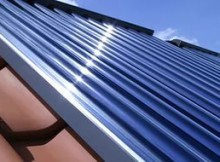 solar heating
solar heating The upward trend in energy prices makes it necessary to look for alternative sources of heat. Solar collectors are one of the popular non-traditional forms of energy production. They are mounted on the roof and included in the heating system equipped with a boiler. Control over the flow of solar energy and regulation of the supply of energy to the boiler to maintain the desired temperature is carried out using automation. The cost of such devices is quite high.
Wind turbines
The use of a wind generator for heating a country house is advisable in combination with a diesel generator and a battery. In this case, the wind-diesel complex works as follows: the battery is charged from wind energy, which is the source of electricity in the house. During the period when calm weather sets in, the energy in the battery is consumed up to a certain point. With its onset, a diesel generator is started, which does not allow an interruption in the power supply.
When an air flow occurs, the diesel generator stops working, and the battery begins to receive a charge from the wind generator.
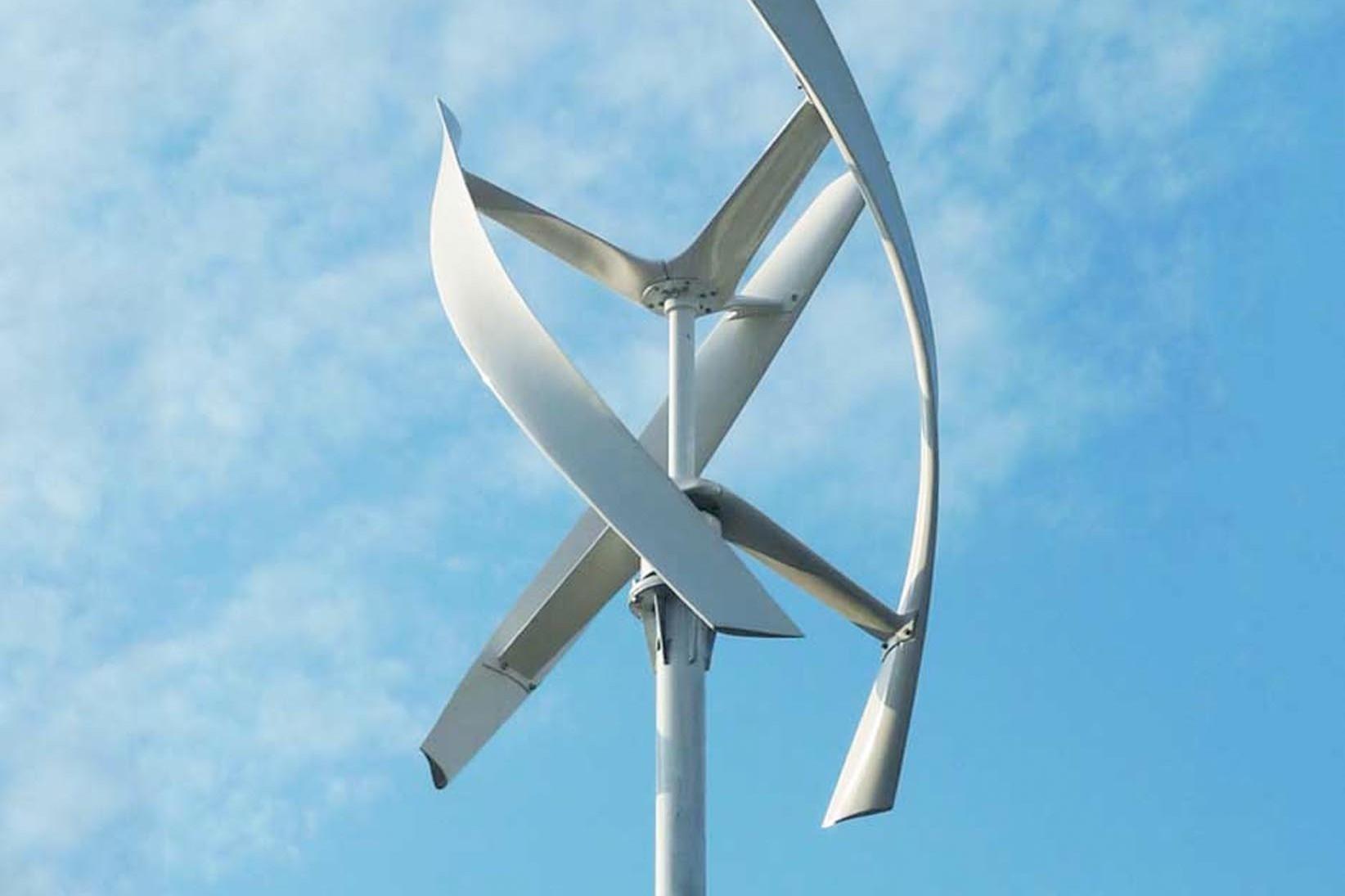 Wind energy for heating
Wind energy for heating Before deciding to install a wind turbine, consider the following:
- Equipment of this kind has a significant cost.
- Absolute dependence on the weather.
- The cost of installation is increased by the purchase of expensive batteries.
- If it is necessary to carry out repair work, their price will also be significant.
- All of these factors generally lead to an increase in the cost of electricity.
The presence of negative points does not lead to a complete negation of the profitability of using a wind generator. In addition to reducing the cost of equipment, the implementation of home heating using it will increase the profitability rate. The reasons for this are as follows:
- The use of low quality electricity will not affect the operation of electric heaters and will make it possible to use equipment with a lower cost.
- You can abandon the batteries, and use a boiler for energy storage, that is, an ordinary container containing a coolant.
- The ability to temporarily maintain the temperature regime in a wide range without the cost of electrical energy.
1.
2.
3.
4.
5.
When equipping heating in a country house with your own hands, it is extremely important to carefully consider many details, otherwise the quality and performance of the installed system will be low. Before proceeding directly to the installation work, it is very important to calculate what the heating scheme of a country house will be, which installation method is better to use in it, and also consider the options for its functioning. These and some other points will be discussed below.
Heating a country house with gas
The choice of a heating system for a country house, as a rule, depends on a number of factors, and often one of the key criteria is the presence or absence of a gas pipeline near the building. If access to this inexpensive and efficient fuel is free, then the most right decision installation will be gas system heat supply. Accordingly, one of the main questions that arises for those owners who decide to connect the gas heating of a country house is how to choose a heating boiler.This element is the main heating source and its selection can be based on different criteria:
- based on how the heating equipment will be operated, boilers can be single-circuit and double-circuit. The first sample is suitable if the only purpose of the boiler is to heat the home. But on condition that if it is required not only to heat the room, but also to heat water for domestic needs, only a two-circuit unit would be a suitable option. Despite its functionality, it will be extremely unprofitable to use a boiler with two circuits in those buildings whose area does not exceed 300 m², since the cost of heating a country house will be too high;
- depending on the method of fixing, floor gas boilers and boilers fixed to the wall surface are also distinguished (the second option will be relevant for houses with an area of \u200b\u200bno more than 200 m², since their sizes are small). In a large building, it is advisable to operate floor-type boilers, which are large in size, but at the same time have significant power;
- considering the methods of heating a country house with the help of gas equipment, it should be noted that the boilers may differ in the type of installed heat exchange element. The most popular designs today are made of copper, steel or cast iron. It should be said here that copper heat exchangers can only be installed in wall-mounted boilers, respectively, in most private houses they are used extremely rarely. Cast iron and steel models have the highest indicators of strength and reliability, so the choice should be directed precisely in their direction;
- a heating device for a country house, where gas is the source of fuel, involves the installation of a chimney pipe, with which you can safely and quickly bring all combustion products out. But many experts today advise paying attention to the so-called turbocharged boilers, for which the installation of a chimney is optional. Their design includes two circuits: through one, oxygen enters the combustion chamber (while it is not taken from the room), and through the other, exhaust gases are discharged to the surface. The draft in these devices is provided due to the presence of a fan in them, due to which its installation does not entail any difficulties.
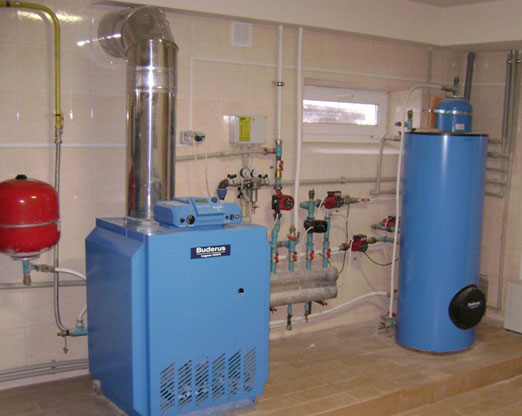
When assembling such a communication as a heating system for a country house, the device diagram requires special attention to be paid to the pipes of the heating circuit, so how to choose these structural elements of the system should be considered in more detail.
What determines the choice of heating pipes
Pipes used for heating private houses can have several varieties that differ in purpose and the material from which they are made.So, if you want to carefully lay pipes along the walls, it is best to use reinforced polypropylene products, since such pipes endure high-temperature effects and do not expand when overheated.
Some heating systems for a country house include collector piping. In this case, samples made of cross-linked polypropylene will be the most suitable, which is explained by the possibility of installing such a pipe in a single and uninterrupted piece. As a result, the risk of violation of the integrity of the pipe is minimized.
Do-it-yourself heating system wiring rules
Various options for heating a country house provide for the implementation of a different type of wiring. So, when working in a one-story private house, it is recommended to place pipes around the entire perimeter with a solid contour (read: ""). Heating batteries should be installed in the same way.In a suburban building with two or three floors, it would be better to carry out a similar wiring on each of the floors, connecting them into one system using a riser.
A fairly common problem faced by many owners is the connection of radiators, the design of which includes side plugs. It is best in this situation to bring the heating pipes in a diagonal way, which will allow the surface of the battery to be evenly heated without leaving “cold” areas on it. Moreover, this version of the device is also convenient in that there will be practically no plaque inside the circuit located in this way.
Sometimes there may be a connection option for the lower radiator plugs. In this case, each of the batteries must be equipped with an additional "air vent".
The main parts of the gas heating system that are directly responsible for heating the coolant are the boiler, pipes and batteries.
However, a system in which water does not move naturally, but in a forced way, includes other important structural elements, including:
- expansion tank. This tank is designed to collect excess liquid that appears during the heating process, and should have a volume of about 10% of the total volume of the heating system;
- safety fittings in the form of a valve, which is responsible for stabilizing the pressure in the circuit and designed to reduce the value of this parameter in the event of a sharp jump;
- element that removes excess air. Mounted, as a rule, at the top of the heating circuit;
- circulation pump. With its help, the coolant easily moves through the pipes, and the most optimal site its installation - a place in front of the boiler (read also: "").
In order not to make a mistake with the choice, you should, of course, study photos of various products, as well as other materials that can help in installation. But most experts are inclined to believe that the optimal heating radiator is an aluminum device. It is this equipment that is distinguished by a long service life, ease of use and, at the same time, affordable cost.
When choosing a gas boiler, it is important to decide what role it will be assigned: whether it will be used only for home heating or it will be a full-fledged equipment that can also heat water for domestic needs.
Advantages of solid fuel boilers
Despite the ease of use of gas heating equipment, many owners today prefer to provide heating of their homes with firewood. This type of heating will be especially relevant in those buildings where there is no direct access to the gas main. In addition, the traditional one with the help of firewood is able to provide comfort indoors and eliminate the release of harmful substances into the atmosphere, since wood, as you know, is the most environmentally friendly type of fuel.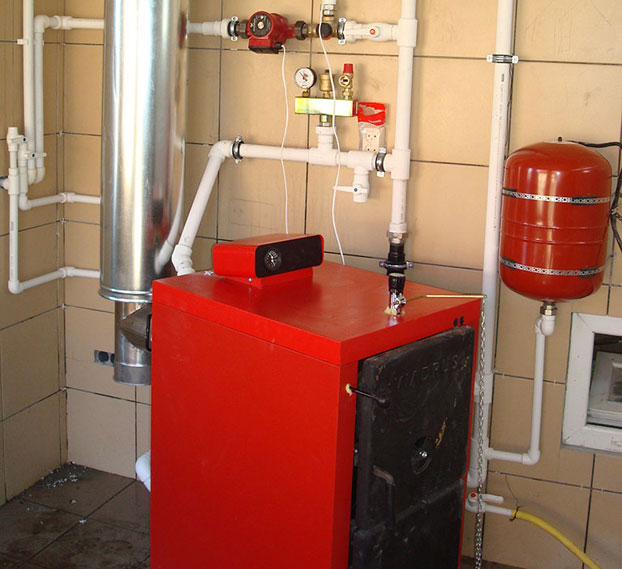
In order to equip solid fuel heating, a prerequisite is the use of a special pyrolysis-type boiler. The peculiarity of this device lies in the fact that its design includes two cameras. In the first of them, the wood burns directly, and in the second, the combustion products of firewood in the form of gas. See also: "".
It is extremely important to ensure normal combustion heat, due to which the gas is released into in large numbers. One of the advantages of the pyrolysis boiler is the large size of the combustion chamber, due to which the boiler is able to function throughout the day without the need for additional fuel loading.
Another pyrolysis-type heating option is the installation of a pyrolysis oven, which has the same advantages as a boiler and allows you to maintain the same temperature in your home for a long time.
Heating a country house from the electrical network
Despite the seeming convenience of this option for heating a private building, do not forget that a regular increase in electricity tariffs requires careful completion of all calculations, otherwise the cost of heating a large area can be very impressive.However, heating with electricity is very convenient, so such a heating system should be considered in more detail.

Of course, the coolant in communication with the electric boiler will still be water. However, here it is worth considering whether it is possible to ensure its uninterrupted supply, since not all private buildings have free access to the water main. Therefore, a more correct and convenient solution would be the installation of special convectors and infrared-based heaters. See also: "".
From the point of view of functionality, the convector is very effective, since with the help of this heater it is possible not only to ensure rapid heating of even a large house, but also to maintain the desired temperature parameter for a long period of time.
The principle of operation of the convector is based on the suction of air from the room through a small hole in the body, which, having instantly warmed up, comes back.
Among the advantages that the use of convectors in country houses has, it is worth highlighting the following:
- the device works so that the air in the room does not dry out;
- installation of convectors does not carry absolutely any complexity;
- due to the wide variety of these devices, it will not be difficult to find the model that will be able to heat a particular room;
- safety of work is ensured by the fact that the design of the convectors includes special fuses designed to prevent overheating of the devices.
- some samples are very expensive;
- electricity consumption is often quite high, which inevitably entails high costs.
Alternatively, you can use infrared-based film, which is also widely used. Its main advantage is the possibility of mounting on the floor and walls. Such a film is able to heat a living space no worse than a heater, and much less energy is required for its operation.
Thus, it can be noted that both gas heating and heating with electricity have their positive and negative sides. Assistance in the installation of heating equipment can always be provided by qualified specialists who always have photos of samples of heating systems, as well as detailed and understandable videos on their correct assembly.



